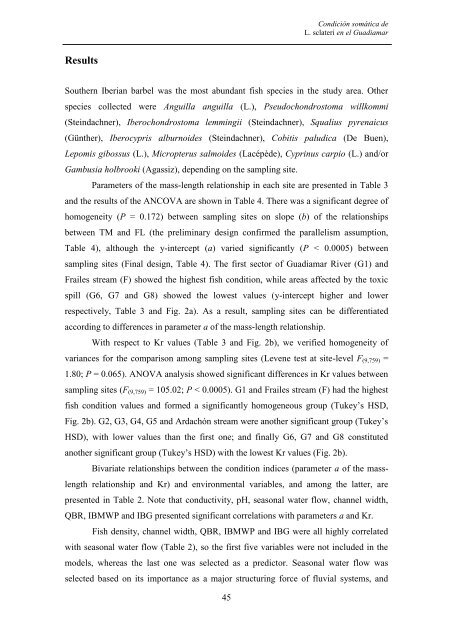las comunidades de peces del río guadiamar y el accidente minero ...
las comunidades de peces del río guadiamar y el accidente minero ...
las comunidades de peces del río guadiamar y el accidente minero ...
You also want an ePaper? Increase the reach of your titles
YUMPU automatically turns print PDFs into web optimized ePapers that Google loves.
Condición somática <strong>de</strong><br />
L. sclateri en <strong>el</strong> Guadiamar<br />
Results<br />
Southern Iberian barb<strong>el</strong> was the most abundant fish species in the study area. Other<br />
species collected were Anguilla anguilla (L.), Pseudochondrostoma willkommi<br />
(Steindachner), Iberochondrostoma lemmingii (Steindachner), Squalius pyrenaicus<br />
(Günther), Iberocypris alburnoi<strong>de</strong>s (Steindachner), Cobitis paludica (De Buen),<br />
Lepomis gibossus (L.), Micropterus salmoi<strong>de</strong>s (Lacépè<strong>de</strong>), Cyprinus carpio (L.) and/or<br />
Gambusia holbrooki (Agassiz), <strong>de</strong>pending on the sampling site.<br />
Parameters of the mass-length r<strong>el</strong>ationship in each site are presented in Table 3<br />
and the results of the ANCOVA are shown in Table 4. There was a significant <strong>de</strong>gree of<br />
homogeneity (P = 0.172) between sampling sites on slope (b) of the r<strong>el</strong>ationships<br />
between TM and FL (the pr<strong>el</strong>iminary <strong>de</strong>sign confirmed the parall<strong>el</strong>ism assumption,<br />
Table 4), although the y-intercept (a) varied significantly (P < 0.0005) between<br />
sampling sites (Final <strong>de</strong>sign, Table 4). The first sector of Guadiamar River (G1) and<br />
Frailes stream (F) showed the highest fish condition, while areas affected by the toxic<br />
spill (G6, G7 and G8) showed the lowest values (y-intercept higher and lower<br />
respectiv<strong>el</strong>y, Table 3 and Fig. 2a). As a result, sampling sites can be differentiated<br />
according to differences in parameter a of the mass-length r<strong>el</strong>ationship.<br />
With respect to Kr values (Table 3 and Fig. 2b), we verified homogeneity of<br />
variances for the comparison among sampling sites (Levene test at site-lev<strong>el</strong> F (9,759) =<br />
1.80; P = 0.065). ANOVA analysis showed significant differences in Kr values between<br />
sampling sites (F (9,759) = 105.02; P < 0.0005). G1 and Frailes stream (F) had the highest<br />
fish condition values and formed a significantly homogeneous group (Tukey’s HSD,<br />
Fig. 2b). G2, G3, G4, G5 and Ardachón stream were another significant group (Tukey’s<br />
HSD), with lower values than the first one; and finally G6, G7 and G8 constituted<br />
another significant group (Tukey’s HSD) with the lowest Kr values (Fig. 2b).<br />
Bivariate r<strong>el</strong>ationships between the condition indices (parameter a of the masslength<br />
r<strong>el</strong>ationship and Kr) and environmental variables, and among the latter, are<br />
presented in Table 2. Note that conductivity, pH, seasonal water flow, chann<strong>el</strong> width,<br />
QBR, IBMWP and IBG presented significant corr<strong>el</strong>ations with parameters a and Kr.<br />
Fish <strong>de</strong>nsity, chann<strong>el</strong> width, QBR, IBMWP and IBG were all highly corr<strong>el</strong>ated<br />
with seasonal water flow (Table 2), so the first five variables were not inclu<strong>de</strong>d in the<br />
mo<strong>de</strong>ls, whereas the <strong>las</strong>t one was s<strong>el</strong>ected as a predictor. Seasonal water flow was<br />
s<strong>el</strong>ected based on its importance as a major structuring force of fluvial systems, and<br />
45

















